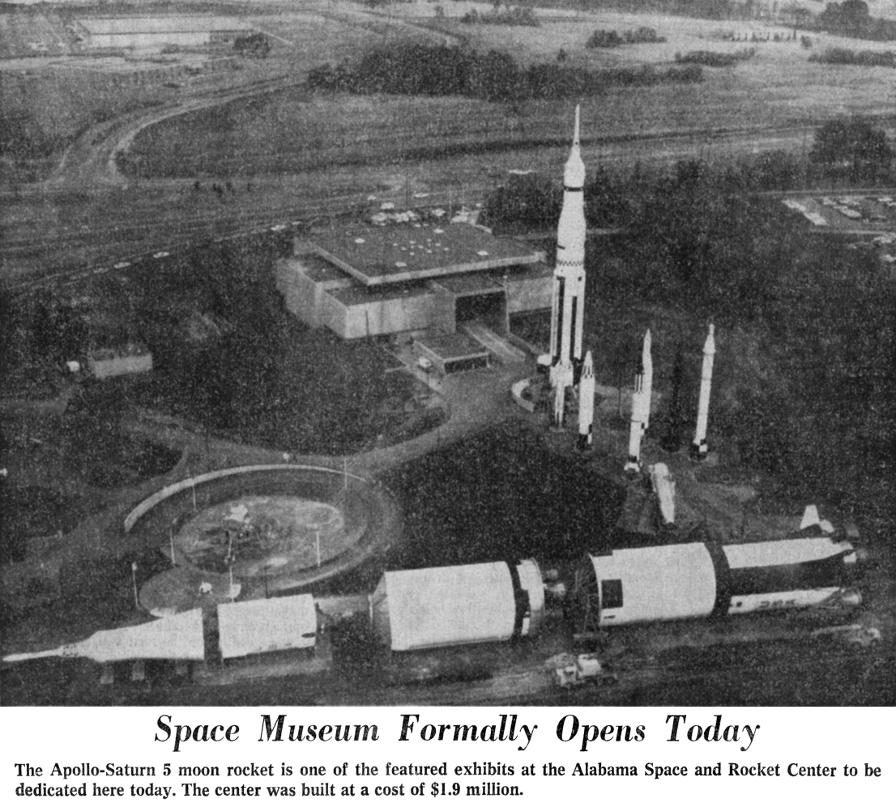Alabama Space & Rocket Center Dedication
During the early days of the Space Race, there were a number of proposals to open a space museum in Huntsville, Alabama.
One proposal, from 1963, would have "Space City USA" be located near the entrance to Redstone Arsenal. It would include an area featuring the "world of dinosaurs, cave dwellers, early civilizations, Indian villages, settler days, and even Civil War days" "displayed under realistic conditions ... similar to Disneyland." It would feature rides, including glass bottom boats, a stern-wheeler steamboat, submarines, and an "authentic 1870 model, narrow gauge, wood burning locomotive." A skyride would allow visitors to "enter the world of the future," with exhibits of the scientific events leading up to manned space flight, a lunar colony situated in a "simulated crater," and even a Mars colony.
An earlier, more down-to-earth (if such a term can be applied to a space museum) proposal, from June 1960, was prepared for the Huntsville-Madison County Chamber of Commerce's Space Science Exhibit Committee. This museum's purpose would be to "commemorate the history, progress, and achievements of the scientific field of rockets, missiles, and space flight for the benefit of present and future generations."
This study included an analysis of a "static or museum type of exhibit" as well as a facility with five or six major ride attractions, "each concerned with some important phase of missiles or space travel" (noting that such rides would have an "educational basis in science or space technology" and would not be "the ordinary type of thrill ride").
This June 1960 proposal is quite remarkable in that it was initiated less than 2½ years after the first U.S. satellite launch (January 31, 1958) and only months after the first unmanned Project Mercury flight (September 9, 1959), shortly before the official formation of Marshall Space Flight Center (July 1, 1960), and a year or more before the first U.S. manned space flight (May 5, 1961) or the first Saturn rocket launch (October 27, 1961).
In the end, the "static" concept was adopted (although the museum would soon add rides in the form of its Lunar Odyssey centrifuge and Zero G machine -- akin to a large teeter-totter).
A state-wide referendum on the issue of bonds to finance the "Alabama Space Science Exhibit" took place on November 30, 1965. Referendum No. 3's supporters included Wernher von Braun, Gov. George Wallace, University of Alabama head football coach Bear Bryant, and Army Missile Command Commanding General John G. Zierdt. The measure was "endorsed overwhelmingly" by the voters, led to the passage of Alabama Code - Section 41-9-430: "Creation; Commission a Public Body Corporate; Commission to Provide, etc., Facilities for Exhibits of National Aeronautics and Space Administration, Department of Army, etc.; Commission Empowered to Provide Lodging for Visitors, etc," and paved the way for what would soon be christened the Alabama Space and Rocket Center.
Although I have a scan of a pamphlet announcing the new museum's "opening fall 1969," the museum's dedication and official opening would have to wait until March 17, 1970.
Click image for a 2213x1994 pixel version of this image in a new window.
From the March 17, 1970 Huntsville
Times.
Scan and cleanup by heroicrelics.

